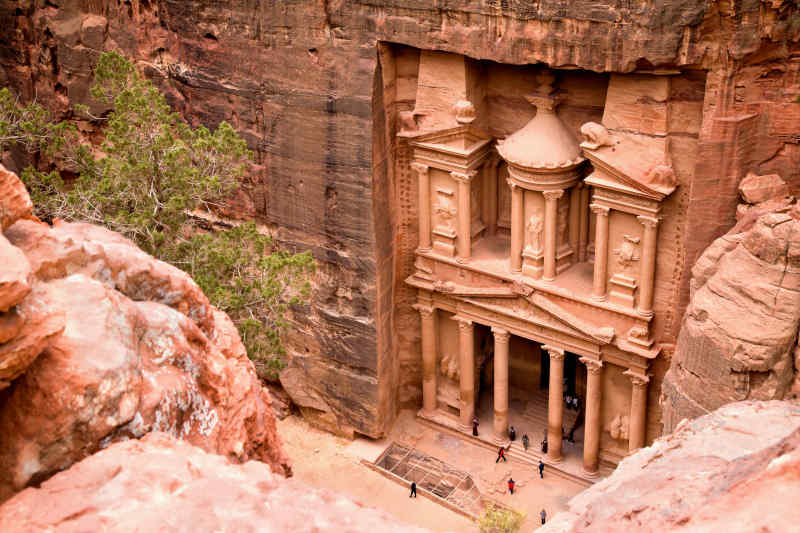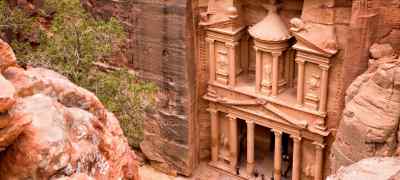By Briana Seftel
Is there an archaeological site more astonishingly beautiful than Petra? It would be hard to find. If you’re planning to visit Jordan’s Lost City, here is a helpful guide to make the most of your trip.
History
Known as the "Rose City" or "Lost City," Petra is one of the greatest surviving wonders of the ancient world. Built some 2,000 years ago by the Nabateans, a nomadic people from Arabia, Petra is ingeniously carved into the blush pink sandstone rock in the high desert of Jordan. The Nabatean capital thrived as a major trading hub until the Romans and Byzantines took possession. A lost civilization, it was rediscovered by Swiss explorer Johann Burckhardt in 1812.
In 1985, Petra was declared a UNESCO World Heritage site and in 2007 it was named one of the new seven wonders of the world.
When to Go
Located in the Jordanian desert, Petra has hot, dry summers and cold winters. If you’d like to see Petra without the crowds, consider visiting in the shoulder season from March-May or September-November. Summer is the busiest time to visit and also the hottest, with temperatures reaching 100F.
The best times to visit Petra is in the early morning or late afternoon, so plan for an early start or arrive the evening before and stay at one of the nearby hotels in Petra.
How to Get There
Petra is a three-hour drive south from Amman on the modern Desert Highway and a four-hour drive on the more scenic Kings’ Highway. If you don’t have a car, you can take a JETT bus leaving from Abdali station. If you’re coming from the port city of Aqaba, the drive is about two hours.
Tickets
Petra is open to visitors from 6 am to 6 pm during the summer and 6 am to 4 pm in the winter. A single one-day ticket costs 50 JD ($70 USD), a two-day costs 55 JD ($77 USD) and a three-day costs 60 JD ($84 USD). Tickets can be purchased via the Visitor Center, and you must have your passport to purchase a ticket.
It is highly recommend that you see Petra with a knowledgeable guide, as there are very few signs explaining the different sites and you would be missing out on a great deal of insight. You can either book a tour before arrival or find a licensed tour guide at the Visitor Center. Rates for a guide start at 50 JD.
What to Bring
Since you’ll be doing a lot of walking in Petra, it’s important to pack only the essentials. Dress comfortably in light, breathable clothing and bring a small backpack or crossbody bag to carry what you need. You can bring a packed lunch or dine at one of the handful of stalls and cafes within the park.
- Good hiking shoes
- Light, loose fitting cotton clothing
- Hat
- Sunglasses
- Sunscreen
- Wide lens camera
- Bottled water
- Cash
What to See
Siq
Upon entering Petra, you will likely walk the nearly mile-long path through the siq, a 250-foot-high canyon leading to the Treasury and other major sights. Walking through the narrow passageway of the siq is an undeniable highlight. Take your time to really experience this natural wonder that was the secret to the success of Petra!
Treasury
Petra’s piece de resistance is the Treasury, also known as Al Khazna. Walking through the siq, you’ll likely gasp as the Treasury reveals itself in all of its equiste, Hellenistic glory. Over 130 feet tall, the Treasury is actually a tomb built for the Nabataean King Aretas III. According to legend, an Egyptian pharaoh hid his treasure here, giving the site its name.
Theater
Originally built by the Nabateans and enlarged by the Romans, the theater is carved into the side of a mountain at the foot of the High Place of Sacrifice. Accommodating 4,000 spectators, the theater was undoubtedly a central place for entertainment and showmanship.
Royal Tombs
Downhill from the theater lies some of the most beautiful burial sites in Petra, known as the Royal Tombs. You’ll first encounter the famous Urn Tomb, used as a place of worship during the Byzantine Empire. You’ll then come across the Silk Tomb, the Palace Tomb, the Corinthian Tomb and the Tomb Of Sesto Fiorentino.
Monastery
One of the largest monuments in Petra, the Monastery is hidden high in the hills and resembles the Treasury, but on a much bigger scale. Follow the 800-step staircase from the Basin Restaurant to reach this awe-inspiring monument used for religious gatherings.
Bonus: Petra by Night
Sit in stunned silence as you observe Petra illuminated by candlelight! Occuring every Monday, Wednesday and Thursday, Petra by Night is a spectacular night show involving over 1,500 candles lit in front of the Treasury. Tickets are 17 JD (23 USD) (not included in standard ticket). Petra by Night starts at 8:30 pm and ends around 10.30 pm.









